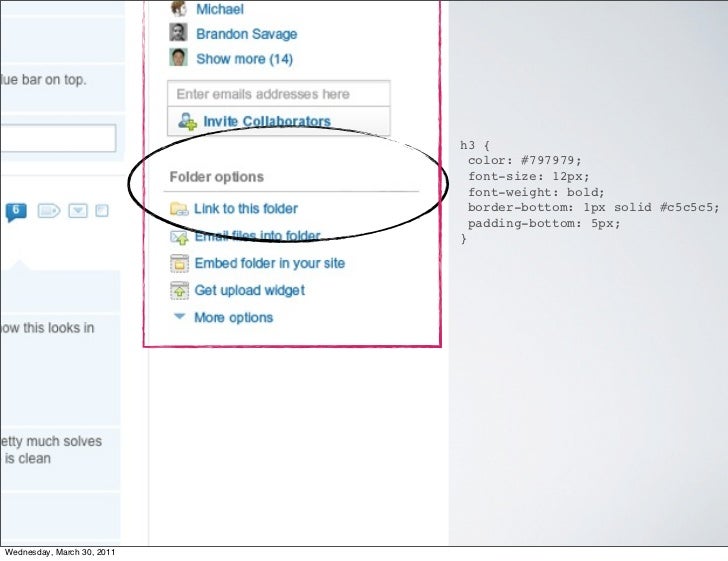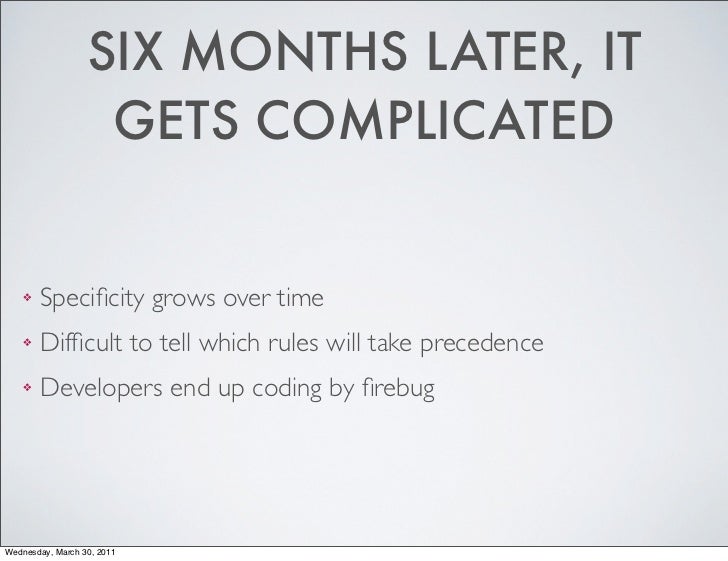贺师俊 - @hax
--
- Web Developer -- @ BaiXing.com
--
We just announced $100 million D round 3 days ago.
--
So it's a good time to...
--
JOIN US
--
- Web Developer @ BaiXing.com
--
- Write first html page in 1998 -- , for IE 4
--
- Love the Web platform
-- , especially the design of CSS
--
- Famous as a critic
--
So let's talk about CSS Frameworks...
-
pre-prepared software frameworks
-
allow for easier, more standards-compliant web design
--
- CSS, of course
--
- JavaScript based functions, design oriented and unobtrusive
--
-
Reset-Stylesheet
-
grid especially for responsive web design
-
web typography
-
set of icons in sprites or iconfonts
-
styling for tooltips, buttons, elements of forms
-
parts of graphical user interfaces like Accordion, tabs, slideshow or Modal windows (Lightbox)
-
Equalizer to create equal height content
-
often used css helper classes (left, hide)
--
- Bootstrap -- (Most stars project on GitHub)
--
- Foundation
--
- Semantic UI
--
No, I don't want to talk about Bootstrap...
No, I don't want to talk about Bootstrap...
--
But, something behind it, for example:
<!DOCTYPE html>
<body>
<div class="container">
<h1>Search</h1>
<label>Example for a simple search form.</label>
<!-- Search form with input field and button -->
<form class="well form-search">
<input type="text" class="input-medium search-query">
<button type="submit" class="btn btn-primary">Search</button>
</form>
<h2>Results</h2>
<!-- Table with alternating cell background color and outer frame -->
<table class="table table-striped table-bordered">
...
</table>
</div>--
Scope CSS classes with prefixes
--
--
Such thought is so called:
/ Philosophy
--
- OOCSS
--
- SMACSS
--
- ACSS
--
- BEM
- Object Oriented CSS
--
--
--
--
--
--
- Separate structure and skin
--
- Separate container and content
#button {
width: 200px;
height: 50px;
padding: 10px;
border: solid 1px #ccc;
background: linear-gradient(#ccc, #222);
box-shadow: rgba(0, 0, 0, .5) 2px 2px 5px;
}
#box {
width: 400px;
overflow: hidden;
border: solid 1px #ccc;
background: linear-gradient(#ccc, #222);
box-shadow: rgba(0, 0, 0, .5) 2px 2px 5px;
}
#widget {
width: 500px;
min-height: 200px;
overflow: auto;
border: solid 1px #ccc;
background: linear-gradient(#ccc, #222);
box-shadow: rgba(0, 0, 0, .5) 2px 2px 5px;
}.button {
width: 200px;
height: 50px;
}
.box {
width: 400px;
overflow: hidden;
}
.widget {
width: 500px;
min-height: 200px;
overflow: auto;
}
.skin {
border: solid 1px #ccc;
background: linear-gradient(#ccc, #222);
box-shadow: rgba(0, 0, 0, .5) 2px 2px 5px;
}<div class="mod simple">
<b class="top"><b class="tl"></b><b class="tr"></b></b>
<div class="inner">
<div class="hd">
<h3>simple</h3>
</div>
<div class="bd">
<p>Body</p>
</div>
</div>
<b class="bottom"><b class="bl"></b><b class="br"></b></b>
</div>/* ----- simple (extends mod) ----- */
.simple .inner {border:1px solid #D7D7D7;-moz-border-radius: 7px;-webkit-border-radius: 7px;border-radius: 7px;}
.simple b{*background-image:url(skin/mod/simple_corners.png);}--
- Avoid the descendent selector (i.e. don't use
.sidebar h3)
--
- Avoid IDs as styling hooks
--
- Avoid attaching classes to elements in your stylesheet (i.e. don't do
div.headerorh1.title)
--
--
--
- Base (element only selector)
--
- Layout (id selector + layout class)
--
- Module (class only selector + descendant selector)
--
- State (class selector)
--
- Theme (override below rules)
--
body.article > #main > #content > #intro > p > b
-- =>
--
.article #intro b
--
(Nest structure of CSS preprocessors)
--
-
classes are indexed
-
right to left
-
Avoid tag selectors for common elements
-
Use class names as the right-most selector
<nav class="l-inline">
<h1>Primary Navigation</h1>
<ul>
<li>About Us
<ul class="l-stacked">
<li>Team</li>
<li>Location</li>
</ul>
</li>
</ul>
</nav>.l-inline li {
display: inline-block;
}
.l-stacked li {
display: block;
}--
.box, .box h2, .box ul, .box p =>
--
.box, .box .hd, .box .bd =>
--
.box, .box-hd, .box-bd
I find that SMACSS is too loose of a convention (that at times contradicts its own advice) --- http://snugug.com/musings/css-strategy
- Atomic CSS
--
--
.mt-20 {
margin-top: 20px;
}
/* Or */
.fl {
float: left;
}--
WTF?
<div class="media">
<a href="http://twitter.com/thierrykoblentz" class="img">
<img src="thierry.jpg" alt="me" width="40" />
</a>
<div class="bd">
@thierrykoblentz 14 minutes ago
</div>
</div>.media .img {
float: left;
margin-right: 10px;
}<a href="http://twitter.com/thierrykoblentz" class="imgExt">.media .imgExt {
float: right;
margin-left: 10px;
}<div id="rightRail">
<div class="media">.media {
margin: 10px;
}
.media,
.bd {
overflow: hidden;
_overflow: visible;
zoom: 1;
}
.media .img {
float: left;
margin-right: 10px;
}
.media .img img {
display: block;
}
.media .imgExt {
float: right;
margin-left: 10px;
}
#rightRail .bd {
font-size: smaller;
}-
Simple changes to the style of our module have resulted in new rules in the style sheet.
-
We are grouping selectors for common styles (.media,.bd {}).
-
Of our six rules, four are context-based.
-
RTL and LTR interfaces become complicated.
<div class="Bfc M-10">
<a href="http://twitter.com/thierrykoblentz" class="Fl-start Mend-10">
<img src="thierry.jpg" alt="me" width="40" />
</a>
<div class="Bfc Fz-s">
@thierrykoblentz 14 minutes ago
</div>
</div>.Bfc {
overflow: hidden;
zoom: 1;
}
.M-10 {
margin: 10px;
}
.Fl-start {
float: left;
}
.Mend-10 {
margin-right: 10px;
}
.Fz-s {
font-size: smaller;
}-
No contextual styling
-
Directions (left and right) are “abstracted.”
-
Good names don't change
-
is about maintenance, not semantics per se.
-
Specificity (lower than inline script)
-
Verbosity (
M-10VSmargin: 10px) -
Scope
-
Portability
-
We leave alone rules that we suspect to be obsolete for fear of breaking something.
-
We create new rules, rather than modify existing ones, because we are not sure the latter is 100% safe.
-
CSS bloat VS HTML bloat: CSS is cachable
--
-
Less bloat
We can build entire modules without adding a single line to the style sheets.
--
-
Faster development
Styles are driven by classes that are not related to content, so we can copy and paste existing modules to get started.
--
-
RTL interface for free
Using start and end keywords makes a lot of sense. It saves us from having to write extra rules for RTL context.
--
-
Better caching
A huge chunk of CSS can be shared across products and properties.
-
Very little maintenance (on the CSS side)
Only a small set of rules are meant to change over time.
--
-
Less abstraction
There is no need to look for rules in a style sheet to figure out the styling of a template. It's all in the markup.
--
-
Third-party development
A third party can hand us a template without having to attach a style sheet (or a style block) to it. No custom rules from third parties means no risk of breakage due to rules that have not been properly namespaced.
-
Practice of the Chinese large sites: kaixing001, 163, etc.
-
Just same as ACSS
--
- Block__Element--Modifier
--
--
-
http://www.smashingmagazine.com/2012/04/16/a-new-front-end-methodology-bem/
-
http://csswizardry.com/2013/01/mindbemding-getting-your-head-round-bem-syntax/
/* This is the Block */
.block {}
/* This is a child of the block that helps to for it */
.block__element {}
/* This modifies the element */
.block--modifier {}<div class="block block--modifier1 block--modifier2">
<div class="block__element">
...
</div>
<div class="block__element block__element--modifier1a">
...
</div>
<div class="block__element block__element--modifier1a block__element--modifier2b">
...
</div>
</div><div class="Title isModified">
<p class="descendant">
</div>--
.Title {}
.Title.isModified {}
.Title .descendant {}所有他操心的其实是使用者如何能清晰快速的在html上挂样式类而不挂错。想明白这点,就会发现所谓前缀式其实并没有什么神秘的力量。假设我们为所谓chained方式引入额外的命名规约,其实也能解决问题。比如所有组件名首字母大写(就好像OO中的klass那样)。
.Btn.success.Alert.success看上去是不是就突然清晰了?
<b:page>
<b:head>
<b:menu>
...
</b:menu>
<e:column>
<b:logo/>
</e:column>
<e:column>
<b:search>
<e:input/>
<e:button>Search</e:button>
</b:search>
</e:column>
<e:column>
<b:auth>
...
</b:auth>
<e:column>
</b:head>
</b:page><xsl:template match="b:menu">
<ul class="menu">
<xsl:apply-templates/>
</ul>
</xsl:template>
<xsl:template match="b:menu/e:item">
<li class="menu__item">
<xsl:apply-templates/>
</li>
<xsl:template>-
所谓的block(块),其实就是UI的构成单元,就是我们常说的widget或者component
-
Workflow是用xml或json写ui然后通过xslt或bemhtml转换到html,然后配合css
-
HTML/CSS只是实现UI的技术,相当于汇编语言
-
其CSS命名约定其实是让编译后的汇编代码能比较容易对应回原始的UI组件的结构
See semantic-ui
<div class="ui stackable center aligned page grid">
<div class="fourteen wide column">
<h1 class="ui inverted icon header">
<img src="/images/icons/pen.png" class="icon image">
Simplify Your Codebase
</h1>
<p>Semantic's conventions are based around <a target="_blank"><b>common usage</b></a> and not prescription. Syntax borrows useful principles from natural language like plurality, tense, and word order so your code explains itself.</p>
<!-- Recursion Omitted (Turtles all the way down) !-->
</div>
</div>--
classes are neither semantic or insemantic; they are sensible or insensible! Stop stressing about ‘semantic’ class names and pick something sensible and futureproof --- @csswizardry , Author of inuit CSS framework which follow OOCSS and BEM
--
-
In Defense of Descendant Selectors and ID Elements by Zeldman
-
为什么会产生 .text-size30 {font-size:30px} (Why the smart guys use .text-size30 {font-size:30px})
--
, 30 June 2008
--
-
External program can replace constant
-
Cost to user-defined names: memory (when writing) and understanding (when reading)
-
Style sheets are short
-
Hard to reuse (c&p)
-
Hard to learn
-
Modular
-
Help for authors, not for the semantic web
--
CSS do NOT have any abstraction mechanism itself, up to now (CSS variables draft)
--
So the only way to "reuse" style rules is "css class hook"
--
- Not sure what's the best solution
--
- HTC, XBL, BECSS, dead
bindingorbehaviorCSS property...
--
- Server-side managed components like ASP.NET WebForms, JSF, etc.
--
- JavaScript frameworks like Bindows, Ext...too many!
--
- CSS frameworks like Bootstrap, Semantic-UI...
--
- Recent client-side MV* frameworks like Angular, Ember, React, etc.
--
- Polymer
--
- But we definitely need it
--
-
工作流程
团队、流程、工具等如果已经适应某种代码规范,改变该代码规范的成本也会很高。而成本更高的则是既有代码的维护。
--
-
组织架构
对于外包来说,每次页面可以都被视为一次性的工作,也就是说,设计本身需要持久可维护的需求根本就不存在,或者说对外包团队来说,为可维护性做额外努力在经济上完全是不合算的。
--
-
分工方式
不仅设计和实现(前端)被分离到了不同的部门,甚至前端本身还被割裂成“重构”和“前端”。仅仅考虑一个部门或一个团队的“效率”,和考虑整体“效率”是不同的。由于设计部门和前端部门的分离,导致沟通成本上升。设计和技术本就存在天然张力,加之部门间天然的扯皮倾向,因此双方都倾向于通过简化自己的对外接口来分清职责,减少沟通成本。于是设计部门的交付物就简化到PSD设计稿,但是PSD设计稿只是效果图,其在传递“设计意图”上是不够的。
--
-
绩效评估
在这样的分工架构下,往往同时引入KPI绩效之类的管理工具。一般而言,像“可维护性”本身就是非常难以被量化为KPI考核指标的。软件开发部门或可通过内部评估来达成,但是维护“设计意图”需要跨部门的沟通协作,所以基本上是mission impossible。至于说语义化、无障碍性等因素也很难真正得到重视从而列入考核指标。
--
-
忙
另外前端作为用户界面的最终实现者,确实最容易受到各种因素的影响,导致“天天很忙”。结果是前端部门也逐渐变为一种接近于以最快完成任务为优先导向的外包团队的方式在工作。在团队内部,也会倾向于单纯考虑开发效率——如在小鱼答案中写的“能有一个 .classname 即可使用别人的外观”——这是一个典型的以样式为中心的行为模式。且因为HTML和CSS反正都是前端写的,如果只看单个项目周期,样式分离的好处其实就是虚的——从而缺乏真正提高可维护性的动力。
--
- Workflow: Information/Content/Semantic-driven VS UI-driven
--
-
Tools: CSS preprocessor
--
-
Do Components in Right Way
- [Custom Element]
- [Shadow DOM]
- [Scoped Style]
- [CSS
unsetvalue]
- CSS extensions
--
Sorry Bert.
--
Semantic CSS With Intelligent Selectors
--
There's no such thing as semantic CSS. There's only semantic HTML and its visible form.










